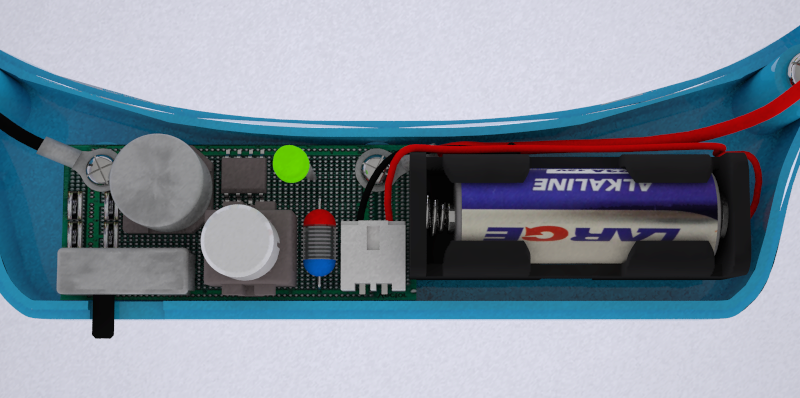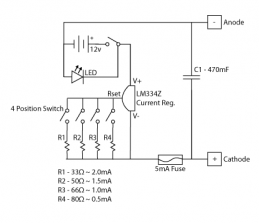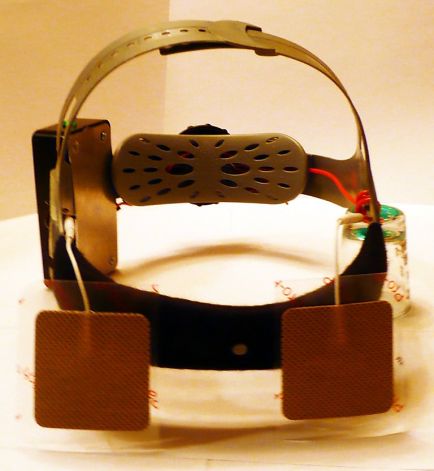GoFlow
| GoFlow | |
|---|---|

|
|
| Category | Transcranial direct-current stimulation |
| Developer | GoFlow |
| Announced | March 2012 [1] |
| Released | Developers:
Consumers: project cancelled [2] |
| Price | 99 USD (March 2012)[3] the device was never shipped |
| Max output | 2 mA2 T 0.002 A [4] |
| Session duration | 18001,800 s 30 minute [5] |
| Scalp location | unspecified |
| Weight | g |
| Controls |
buttons [6] |
| Data available | |
| Risk factor | |
| Medical prescription | No |
| http://www.diytdcs.com/tag/goflow/ | |
GoFlow should be small head mounted device which provides transcranial direct-current stimulation. The device was developed by students at the University of Michigan and was announced as first direct-to-consumer tDCS device. It was, however, never shipped due to FDA concerns.[1]
GoFlow consists of head-mounted device, which includes two sponge electrodes, potentiometer,[5] 12 V battery[6] and 5 mA safety fuse[4]. It should have been shipped with the map of brain regions, in order to let users know the proper placement of electrodes.[5]
Contents
Main characteristics
Go Flow is head mounted plastic tDCS device which is standalone. There are placed two electrodes on the device, anode and cathode. While the prototype of the device seemed to use sticky electrodes [3] the developed device contained sponge electrodes.[6] There is stated elsewhere that tDCS devices used 9 V battery[5][7], even though, the photographs of the final form of GoFlow suggest that it contains 12 V battery.[6] From the photographs also follows that the device is controlled by buttons in the back side of the device.[6]
The manufacturers of GoFlow intended to develop the first low-cost commercial tDCS device.[4] Due to FDA concerns, GoFlow's Kickstarter campaign was cancelled.[8] Although, they claim the willingness to continue the project[8], later on they sold their mailing list to Foc.us and abandoned the project.[1] Consequently, they supported Foc.us device which was shipped from June 2013.[2] As an allusion to this cancelled project, Foc.us entitled one of their devices Go Flow.[9]
Purpose
The main purpose is to enhance skills of its users by low-cost and publicly available tDCS device.
Company & People
GoFlow was originally developed by students at the University of Michigan but it has never been shipped.
- Matt Sornson - the co-founder of GoFlow
- Nick Woodhams - the co-founder of GoFlow[1]
- Benjamin Syzek - Ph.D neuroscience student at Michigan State University[10]
Important Dates
- spring 2012 - the new device was announced and the Kickstarter campaign began
- May 2012 - the Kickstarter campaign was delayed and later cancelled because of FDA involvement
- early 2013 - the developers give up the development of an available tDCS device and sold the project to the Foc.us company
- summer 2013 - the first device tDCS which was produced by Foc.us was released[1]
Enhancement/Therapy/Treatment
GoFlow should have caused a "flow state" to its users. This is the state of intense concentration and appears among artists, athletes or workers.[4] The developers refer to the research conducted by the US Army and DARPA, which suggested that tDCS increased the amount the tested subject learnt.[3]
In the video placed at Youtube authors claim that GoFlow increase cognitive and learning performance and motor ability. [11]
The papers which discussed GoFlow also mention that tDCS devices were used for the treatment of Parkinson’s disease, post-stroke motor dysfunction,[5]
Ethical & Health Issues
There are several ethical and health issues linked with tDCS in general or DTC tDCS specifically.
Public & Media Impact and Presentation
Several authors pointed out that the presentation of the project was not really professional. Tim Verry from PC Perspectives claimed:
Personally, statements such as "our tDCS kit is the shit" and "get one of the first β1's and will help us develop β2" on the web[site] are not exactly instilling confidence to me, but if you're big into the early adopter adventure, GoFlow may have something for you to test.[7]
and Christopher Mims at MIT Technology Review argued:
Given the (lack of) production values in their promotional video, I’m not all that reassured by the included testimonial from a neuroscience graduate student.[12]
Public Policy
Related Technologies, Projects or Scientific Research
References
- ↑ 1.0 1.1 1.2 1.3 1.4 WEXLER, Anna. A pragmatic analysis of the regulation of consumer transcranial direct current stimulation (TDCS) devices in the United States. Journal of Law and the Biosciences [online]. 2015, Oct 12. Available online at: http://jlb.oxfordjournals.org/content/2/3/669.full.pdf+html (Retrieved 1st November, 2016).
- ↑ 2.0 2.1 JOHN. News from GoFlow! Good and Bad. DIY tDCS [online] 2013, Jun 7. Available online at: http://www.diytdcs.com/2013/06/news-from-goflow-good-and-bad/ (Retrieved 1st November, 2016).
- ↑ 3.0 3.1 3.2 JOHN. GoFlow: Learn Faster. DIY tDCS [online]. 2012, Mar 17. Available online at: http://www.diytdcs.com/2012/03/goflow-learn-faster/ (Retrieved 21st November, 2016).
- ↑ 4.0 4.1 4.2 4.3 VANCE, Ashlee. A brain charger for $100 - but will it work?. SFGate [online]. 2012, Mar 25. Available online at: http://www.sfgate.com/business/article/A-brain-charger-for-100-but-will-it-work-3432153.php#ixzz25TjyRopo (Retrieved 21st November, 2016).
- ↑ 5.0 5.1 5.2 5.3 5.4 ANTHONY, Sebastian. GoFlow: a DIY tDCS brain-boosting kit. ExtremeTech [online]. 2012, Mar 9. Available online at: http://www.extremetech.com/extreme/121861-goflow-a-diy-tdcs-brain-boosting-kit (Retrieved 21st November, 2016).
- ↑ 6.0 6.1 6.2 6.3 6.4 WRIGHT, Karl Is. GoFlow Provides DIY Transcranial direct-current stimulation (tDCS). UserHaven [online]. 2012, Mar 22. Available online at: http://userhaven.com/biohacking/goflow-provides-diy-transcranial-direct-current-stimulation/ (Retrieved 21st November, 2016).
- ↑ 7.0 7.1 VERRY, Tim. GoFlow To Offer $99 tDCS Brain Augmentation Kit. PC Perspective [online]. 2012, Mar 12. Available online at: https://www.pcper.com/news/General-Tech/GoFlow-Offer-99-tDCS-Brain-Augmentation-Kit (Retrieved 21st November, 2016).
- ↑ 8.0 8.1 JOHN. GoFlow Kickstarter Campaign DENIED! DIY tDCS [online] 2013, Jun 7. Available online at: http://www.diytdcs.com/2012/05/goflow-kickstarter-campaign-denied/(Retrieved 21st November, 2016).
- ↑ OXLEY, Michael. The Story of Focus Go Flow. Foc.us Blog [online]. 2016, Jan 5. Available online at: https://www.foc.us/blog/the-story-of-focus-go-flow.html (Retrieved 14th November, 2016).
- ↑ WEBSTER, Andrew. GoFlow kit lets you build your own brain stimulation machine for $99. The Verge [online]. 2012, Mar 14. Available online at: http://www.theverge.com/2012/3/14/2871740/goflow-kit-tdcs-brain-stimulation (Retrieved 21st November, 2016).
- ↑ FLOWSTATEENGAGED'S CHANNEL. GoFlow β1 - Funfomercial. Youtube [online]. https://www.youtube.com/watch?v=0ZDD880rSSk (Retrieved 22nd November, 2016).
- ↑ MIMS, Christopher. DIY Kit Overclocks Your Brain With Direct Current. MIT Technology Review [online]. 2012, Mar 09. Available online at: https://www.technologyreview.com/s/427177/diy-kit-overclocks-your-brain-with-direct-current/ (Retrieved 21st November, 2016).


